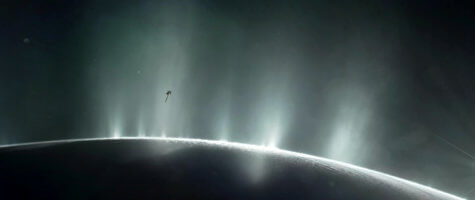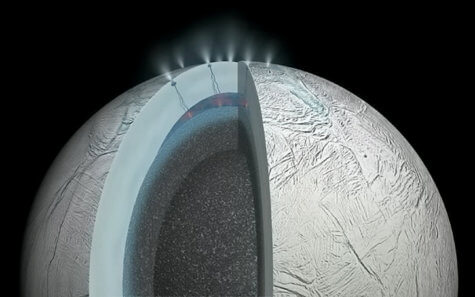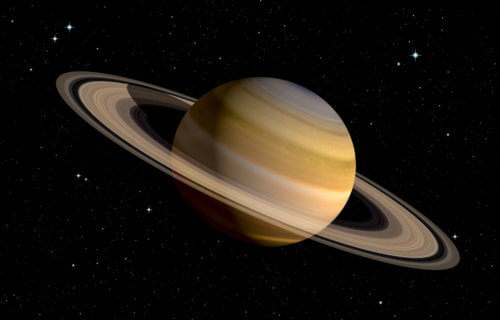TUCSON, Ariz. — Plumes of water shooting from Saturn’s Enceladus moon have fascinated scientists for years. Research and speculation about the ocean between the core of the moon and its icy shell has come about as a result. Scientists now say chemicals in the massive plumes could signal alien life.
NASA’s Cassini spacecraft flew through the plumes, investigating their chemical makeup. The craft detected a high concentration of molecules associated with vents on the bottom of Earth’s oceans. These included methane, carbon dioxide and dihydrogen. The amount of methane found in the plumes, however, were unexpectedly high.
“We wanted to know: Could earth-like microbes that ‘eat’ the dihydrogen and produce methane explain the surprisingly large amount of methane detected by Cassini?” says Regis Ferriere, a lead author on the study and associate professor at the University of Arizona’s Department of Ecology and Evolutionary Biology, in a statement. “Searching for such microbes, known as methanogens, at Enceladus’ seafloor would require extremely challenging deep-dive missions that are not in sight for several decades.”

The team constructed mathematical models to calculate the probability of different processes to explain the Cassini spacecraft data. They think that while not proof, the data’s conclusion does not rule out microbial life on Saturn.
“In summary, not only could we evaluate whether Cassini’s observations are compatible with an environment habitable for life, but we could also make quantitative predictions about observations to be expected, should methanogenesis actually occur at Enceladus’ seafloor,” adds Ferriere. “Obviously, we are not concluding that life exists in Enceladus’ ocean. Rather, we wanted to understand how likely it would be that Enceladus’ hydrothermal vents could be habitable to Earth like microorganisms. Very likely, the Cassini data tell us, according to our models.
“And biological methanogenesis appears to be compatible with the data,” the professor continues. “In other words, we can’t discard the ‘life hypothesis’ as highly improbable. To reject the life hypothesis, we need more data from future missions.”
Hydrothermal activity occurs on Earth when cold seawater seeps onto the ocean floor, circulates through the rock and passes close to a heat source. It then spews out to the water again through hydrothermal vents.
On Earth, methane can be produced through hydrothermal activity at a slow rate. Most production is due to microorganisms which harness the chemical imbalance of hydrothermally produced dihydrogen as a source of energy. They produce methane from carbon dioxide in a process called methanogenesis.

The team looked at the composition of the plumes as the result of several chemical and physical processes happening in the interior of Saturn’s moon. Researchers assessed what hydrothermal production of dihydrogen would fit Cassini’s observations. They also assessed whether the production could provide enough ‘food’ for a population of Earth-like methane microorganisms.
The team developed a model for the population dynamics of the methane microorganisms, modeled after known strains from earth. Authors ran the model to see whether chemical conditions such as the concentration of dihydrogen in the hydrothermal fluid would allow microbes to grow. They also looked at the effect of a microbe population on its environment, for example on the escape rates of dihydrogen and methane in the plume.
Results suggest methane production without biological aid is not sufficient to explain the concentration found in the plumes. Adding biological methanogenesis could produce enough methane to match Cassini’s observations.
The authors hope their paper can act as guidance for studies aimed to understand Cassini’s observations better. Their findings could encourage research to explain the processes which could produce enough methane to get the data.
Methane may come from the chemical breakdown of organic matter that could be present in the core of the Enceladus moon. It could be partially turned into dihydrogen, methane and carbon dioxide. Professor Ferriere explains that the hypothesis is plausible if it turns out Enceladus formed through the increase of organic-rich material supplied by comets.
“It partly boils down to how probable we believe different hypotheses are to begin with,” he concludes. “For example, if we deem the probability of life in Enceladus to be extremely low, then such alternative abiotic mechanisms become much more likely, even if they are very alien compared to what we know here on Earth.”
The authors say a promising advance of the paper lies in its methodology as it is not limited to systems like interior oceans of icy moons. It paves the way to deal with chemical data from planets outside the solar system as they are available in the coming decades.
The findings were published in the journal Nature Astronomy.
SWNS writer Olivia Devereux-Evans contributed to this report.
